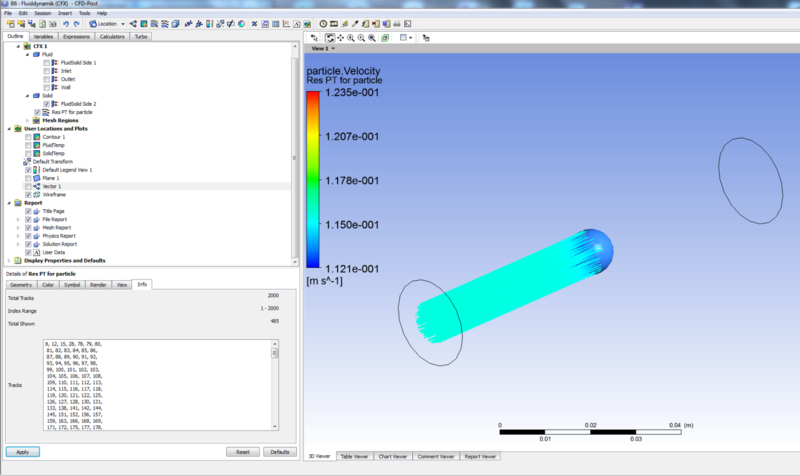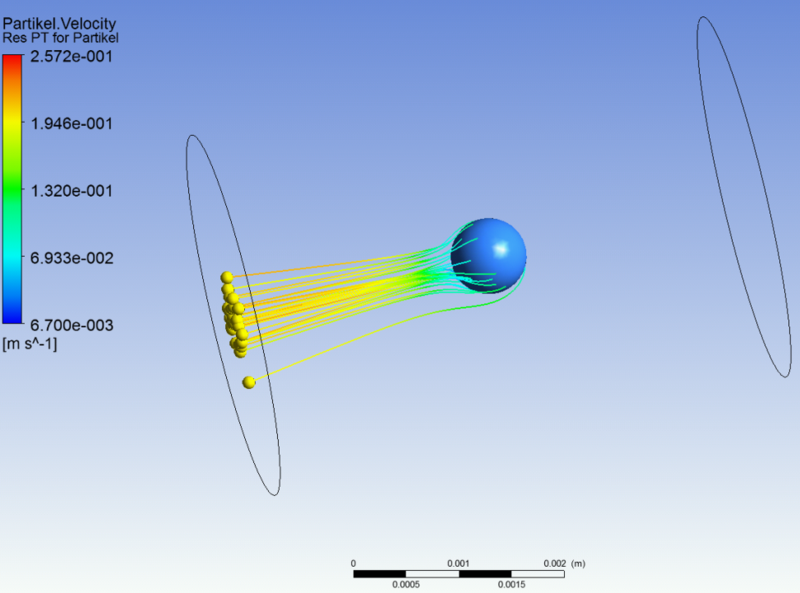 |
|
|
[Sponsors] | |||||
Particle Deposition in Granular Beds (Tracking) |
 |
|
|
LinkBack | Thread Tools | Search this Thread | Display Modes |
|
|
|
#1 |
|
New Member
Greg
Join Date: Dec 2013
Posts: 6
Rep Power: 12  |
Dear CFX-forum,
in my master-thesis I'm simulating the dust-deposition in granular beds. I need to track particles (around 10k) from my inlet to my outlet to figure out, how many particles get stuck in my granular bed, which are spheres, to determine the efficiency of the filter. First of all I'm simulating steady-state with only one sphere. I managed to track particles and I managed to view them on my spheres (look at picture), but I dont know which transport-mechanismens are used specifically. I guess it is inertia and if buoancy is activated gravitation. Additionally I need particle diffusion and interception. Interception I think is a boundary condition, but what is the particle diffusion? Do I calculate it with the turbulent kinematic diffusion? I read something about it in the help, but I'm not sure. I made a really fine mesh around my sphere to get my very tiny particles (0,01 micron) tracked, but the number of particle-hits does not vary very much, although I differ the particle-diameter a lot (0,01 - 100 micron). I constantly dont get many hits around 1 to 20 micron, which could be my global minimum single sphere efficiency postulated in literature. In Theory you get a lot of hits at very small particle sizes, cause of diffusion and a lot of hits at large particles because of inertia. Because of these facts, I assume diffusion is already calculated in my simulation (I have the k-epsilon modell activated at medium intensity). So my questions is, how do I calculate the particle diffusion? I also highly appreciate any other tips  . . low inertia low inertia high inertia high inertiaThanks in advance and greetings Tantal Last edited by Tantal; December 14, 2013 at 10:12. |
|
|
|

|
|
|
|
|
#2 |
|
Super Moderator
Glenn Horrocks
Join Date: Mar 2009
Location: Sydney, Australia
Posts: 17,703
Rep Power: 143     |
I assume by particle diffusion you mean turbulent diffusion. This is simply an option you turn on in the particle tracking options.
I would have though a Stokes number calculation and estimates of particle slip would allow you to estimate the answer without even touching CFD. |
|
|
|

|
|
|
|
|
#3 |
|
New Member
Greg
Join Date: Dec 2013
Posts: 6
Rep Power: 12  |
Thank you ghorrocks,
but I'm a beginner and I'm not sure what you exactly mean with "turbulent diffusion". Do you mean "Turbulent Dispersion Force" in the tab "Fluid Pair Models" under "Non-drag Forces"? I will consider your idea about the Stokes-Number. Thanks |
|
|
|

|
|
|
|
|
#4 |
|
Super Moderator
Glenn Horrocks
Join Date: Mar 2009
Location: Sydney, Australia
Posts: 17,703
Rep Power: 143     |
Yes, that is correct. That is the only force I am aware of in multiphase particle tracking which causes particles to disperse.
|
|
|
|

|
|
|
|
|
#5 |
|
New Member
Greg
Join Date: Dec 2013
Posts: 6
Rep Power: 12  |
Great thanks
 . .Was my assumption right, that I only had simulated inertia and gravity in a turbulent flow-field, but without its particle interaction? Many Thanks and greetings |
|
|
|

|
|
|
|
|
#6 | |
|
Super Moderator
Glenn Horrocks
Join Date: Mar 2009
Location: Sydney, Australia
Posts: 17,703
Rep Power: 143     |
On second thought, particle collision models can also lead to particle dispersion as well I guess. So that's a second mechanism. So can particle breakup but I don't think you have that.
Quote:
|
||
|
|

|
||
|
|
|
#7 |
|
New Member
Greg
Join Date: Dec 2013
Posts: 6
Rep Power: 12  |
thanks again!
i switched on the dispersion force (particle mass is very low!) and the results are as expected! I made a simulation with a own written MatLab-program for Brownian-diffusion and the streamlines are quite similar.  So overall I have 3/4 of my transport-mechanisms: Inertia, diffusion and gravitiy. The last one, which is missing is the interception. This means, that particles get stuck on the sphere, if they come closer than their radius. Now I think my particles are treated as point-masses with no physical length. How do you do this? Do I need some new selections (boundary-conditions), which are around my sphere with the addition radius of my particles? This picture shows what I'm talking about:  if the particles are point-masses and follow the blue streamlines of the fluid, they would not hit the red sphere, but because of their length, they hit. I hope somebody can give me some advices. Thanks 
|
|
|
|

|
|
|
|
|
#8 |
|
Super Moderator
Glenn Horrocks
Join Date: Mar 2009
Location: Sydney, Australia
Posts: 17,703
Rep Power: 143     |
Yes, CFX treats particles as points.Are you sure this effect makes a difference? Your particles sound very small, so the radius you are talking about is tiny.
I think the easiest way to do this is by using a user fortran routine with custom particle termination. It should be pretty easy as your termination criteria is very simple. |
|
|
|

|
|
|
|
|
#9 |
|
New Member
Greg
Join Date: Dec 2013
Posts: 6
Rep Power: 12  |
Yes, this effect counts! My spheres are only 360 micron in diameter and my particles are about 0,01 to 100 micron. So "inertialess" particles, which follow the streamlines, will hit the spheres, because the streamlines are very close to the spheres.
Ok I understand, I need to do a fortran routine..that will we "fun"  . .And you are sure, there is absolutely no other option for that? Thanks anyways! |
|
|
|

|
|
|
|
|
#10 |
|
Super Moderator
Glenn Horrocks
Join Date: Mar 2009
Location: Sydney, Australia
Posts: 17,703
Rep Power: 143     |
I am glad you are looking forward to some fun.
I have had a quick look and I cannot see any other way of doing it. Feel free to have a look yourself, I might have missed it. But there is an example of using a user fortran routine to do particle termination in the <CFX_ROOT>/examples/Userfortran directory so hopefully that will assist in the fun. |
|
|
|

|
|
|
|
|
#11 |
|
New Member
Greg
Join Date: Dec 2013
Posts: 6
Rep Power: 12  |
back hi again
 i had some "fun" writing those user routines, but I finally managed with the help of the Ansys support to get this working. As you can see on the picture in my opening post, I need the coordinates of my solid sphere. How do I get them? I read something about a rbstate(Position X)@Rigid Body but I cant replace my sphere with a rigid body. Any ideas? Do I have to make a local coordinate system? thanks in advance and greetings |
|
|
|

|
|
|
|
|
#12 |
|
Super Moderator
Glenn Horrocks
Join Date: Mar 2009
Location: Sydney, Australia
Posts: 17,703
Rep Power: 143     |
If you generate your sphere as a geometric body you could use something like areaAve()@SphereSurface.
|
|
|
|

|
|
 |
| Tags |
| cfx, deposition, particle, tracking |
|
|
 Similar Threads
Similar Threads
|
||||
| Thread | Thread Starter | Forum | Replies | Last Post |
| dispersion model with lagragian particle tracking model for incompressible flows | eelcovv | OpenFOAM Running, Solving & CFD | 54 | April 10, 2018 09:36 |
| Blood Damage Modelling via Particle Tracking in a Centrifugal Heart Pump | scatman | CFX | 7 | January 8, 2018 00:59 |
| Ubuntu 12.10 + openfoam2.2.0 ==> paraview error message | peteryuan | OpenFOAM Installation | 6 | August 18, 2013 18:00 |
| [OpenFOAM] ParaView ErrOr | soheil nazmdeh | ParaView | 1 | August 17, 2013 07:40 |
| injection problem | Mark New | FLUENT | 0 | August 4, 2013 01:30 |